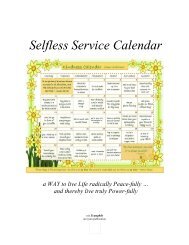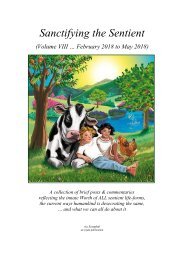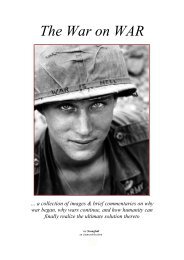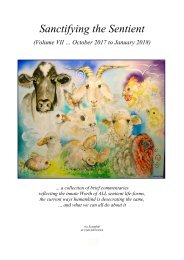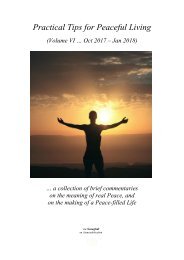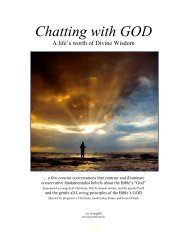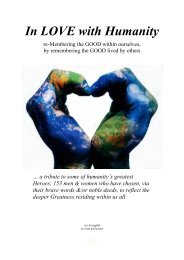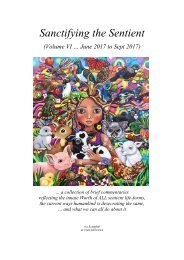Licking the Razor's Edge (2015)
Recognizing the hidden addictions that bind you, … to then set your True Self free
Recognizing the hidden addictions that bind you,
… to then set your True Self free
You also want an ePaper? Increase the reach of your titles
YUMPU automatically turns print PDFs into web optimized ePapers that Google loves.
While <strong>the</strong> existence of such a dysfunction does not mean that <strong>the</strong> couple is “wrong” for<br />
each o<strong>the</strong>r, it does mean that one or both members in <strong>the</strong> relationship has lost focus on<br />
what it truly means to be in a Loving Partnership … Essentially, <strong>the</strong>y have forgotten what<br />
it means to LOVE.<br />
“LOVE ADDICTION” IS EXTREMELY COMMON<br />
Initially, “Love addiction” is BIOLOGICAL … Our bodies are physiologically designed<br />
to procreate. As such, we are subconsciously driven to seek and bond with partners in<br />
order to mate and fur<strong>the</strong>r <strong>the</strong> survival of our species. This is all fine & good, of course,<br />
and yet <strong>the</strong> way our bodies encourage us to do this is so powerful that it often leads us to<br />
becoming addicted to “love”. Whenever a “good match” is encountered, chemicals begin<br />
coursing through our bodies that encourage us to pursue this potential mate at all costs.<br />
And when that union is consummated, that cocktail of dopamine, oxytocin, serotonin, and<br />
adrenaline keeps us literally “stoned” on this “love” for up to 18 months* – a hormone<br />
high that becomes incredibly addictive indeed.<br />
*As soon as <strong>the</strong>se post-sexual union, “in love” hormones fade (usually after around 6<br />
months of toge<strong>the</strong>rness), <strong>the</strong>y are replaced by a surge in endorphins, hormones that give<br />
<strong>the</strong> pair a “best friend” feeling whenever <strong>the</strong>y are toge<strong>the</strong>r. These endorphins are<br />
produced for up to seven years after <strong>the</strong> consummation of <strong>the</strong> relationship. It is<br />
interesting to note that <strong>the</strong> average length of any marriage is … seven years.<br />
Secondly, “Love addiction” is PSYCHOLOGICAL … Humans are “herd animals”;<br />
social beings programmed to join toge<strong>the</strong>r in like-minded groups in order to survive and<br />
thrive. As a consequence, over time we have developed very powerful subconscious<br />
“programs” in <strong>the</strong> most primitive portions of our brains – a set of drives & inclinations<br />
designed to encourage us to survive at all costs, and to do so by forming “stable” bonds<br />
with o<strong>the</strong>rs. As such, we all subconsciously yearn to be loved, we all subconsciously<br />
yearn to please o<strong>the</strong>rs, and we all subconsciously yearn to form “permanent unions” with<br />
o<strong>the</strong>rs in order to make our lives “safer” and “more successful”. And, whenever we<br />
choose to heed <strong>the</strong>se self-serving and fear-based inclinations, we logically engage<br />
relationships that are dysfunctional and needy. And in this way, too, we become addicted<br />
to “love”.<br />
Finally, “Love addiction” is CULTURAL … Now that we understand that both our<br />
bodies and our minds are innately “dysfunctional”, it can be no surprise to realize that <strong>the</strong><br />
cultures that those bodies and minds have created are equally unhealthy. Indeed, with <strong>the</strong><br />
exception of a very few tribal cultures, human societies have been developed in such a<br />
way as to actually encourage us to addictively attach to o<strong>the</strong>rs around us. Films and<br />
novels, of course, are <strong>the</strong> most obvious perpetrators – shamelessly propagating <strong>the</strong><br />
insidious myth that Love is fundamentally romantic and blatantly “needy”. And yet, <strong>the</strong><br />
most powerful “culprit” in <strong>the</strong> spread of this deep-seated dis-ease is <strong>the</strong> basic familydynamic.<br />
Dysfunction if our relationships is not only biologically programmed, it is also<br />
a learned behavior, stemming from any situation where children are raised in an<br />
environment with rules in place that hinder personal development.<br />
75








